Harnessing the Potential of Walnut Leaves from Nerpio: Unveiling Extraction Techniques and Bioactivity Through Caenorhabditis elegans Studies
Abstract
1. Introduction
2. Materials and Methods
2.1. Plant Material
2.2. Extraction Procedure
2.3. Analysis of Phenolic Compounds by HPLC-DAD-MS
2.4. Evaluation of Walnut Leaves Bioactivities
2.4.1. Experimental Conditions for Caenorhabditis elegans Cultivation and Maintenance
2.4.2. Preparation of Walnut Leaf Solutions
2.4.3. Purification of Free Phenolics from Walnut Leaves
2.4.4. In Vivo Toxicity
2.4.5. Thermal Stress Resistance Assay
2.4.6. Oxidative Stress Induced by Juglone
2.4.7. Fertility Assay with Daf-2(e1370) Strain
2.4.8. Paralysis Assay in GMC101 Strain
2.4.9. Locomotion Assay in NL5901 Strain
2.5. Statistical Analysis
3. Results and Discussion
3.1. Effect of Extraction Methods on Different Phenolic Compounds of Walnut Leaf Extracts
3.1.1. Effect of Extraction Methods on Walnut Leaf Extracts’ Total Phenolic Compounds Content
3.1.2. Effect of Extraction Methods on the Total Content of Phenolic Acids, Flavonoids, and Naphthoquinones
3.2. Characterization of Phenolic Components in Walnut Leaf Extracts
3.2.1. Phenolic Acids
3.2.2. Flavonoids
3.2.3. Naphthoquinones
3.3. Comparison of Individual Phenolic Compounds for Walnut Leaf Extracts
3.4. In Vivo Toxicity of Walnut Leaves
3.5. Walnut Leaf Extract Enhanced Thermal and Oxidative Stress Resistance in C. elegans
3.6. The Effect of Walnut Extracts on Promoting Fertility in a Mutant of Insulin Pathway Daf-2(e1370)
3.7. Effect of Walnut Leaf Extracts to Delay the β-amyloid (Aβ)-Induced Paralysis of Transgenic C. elegans Model of Alzheimer’s Disease
3.8. Motility Impairment in NL5901 Strain Is Ameliorated in Response to Walnut Leaf Extract
4. Conclusions
Supplementary Materials
Author Contributions
Funding
Institutional Review Board Statement
Informed Consent Statement
Data Availability Statement
Acknowledgments
Conflicts of Interest
References
- Bujdoso, G.; Cseke, K. The Persian (English) Walnut (Juglans regia L.) Assortment of Hungary: Nut Characteristics and Origin. Sci. Hortic. 2021, 283, 110035. [Google Scholar] [CrossRef]
- Ortiz, A.L.G.; Berti, F.; Navarini, L.; Crisafulli, P.; Colomban, S.; Forzato, C. Aqueous Extracts of Walnut (Juglans regia L.) Leaves: Quantitative Analyses of Hydroxycinnamic and Chlorogenic Acids. J. Chromatogr. Sci. 2018, 56, 753–760. [Google Scholar] [CrossRef] [PubMed]
- Nour, V.; Trandafir, I.; Cosmulescu, S. HPLC Determination of Phenolic Acids, Flavonoids and Juglone in Walnut Leaves. J. Chromatogr. Sci. 2013, 51, 883–890. [Google Scholar] [CrossRef]
- Zhao, M.H.; Jiang, Z.T.; Liu, T.; Li, R. Flavonoids in Juglans regia L. Leaves and Evaluation of in Vitro Antioxidant Activity via Intracellular and Chemical Methods. Sci. World J. 2014, 2014, 1–6. [Google Scholar] [CrossRef]
- Żurek, N.; Pycia, K.; Pawłowska, A.; Potocki, L.; Kapusta, I.T. Chemical Profiling, Bioactive Properties, and Anticancer and Antimicrobial Potential of Juglans regia L. Leaves. Mol. 2023, 28, 1989. [Google Scholar] [CrossRef] [PubMed]
- Medic, A.; Zamljen, T.; Hudina, M.; Veberic, R. Identification and Quantification of Naphthoquinones and Other Phenolic Compounds in Leaves, Petioles, Bark, Roots, and Buds of Juglans regia L., Using HPLC-MS/MS. Horticulturae 2021, 7, 326. [Google Scholar] [CrossRef]
- Cobzaru, C.; Serban, A.-N.; Cernatescu, C. Progress of Cryogenics and Isotopes Separation identification and analysis of tanins in extracts from walnuts green fruits and leaves. Smart Energy Sustain. Environ. 2019, 22, 103–112. [Google Scholar]
- Giura, S.; Botu, M.; Vulpe, M.; Vîjan, L.E.; Mitrea, R. Evolution of Polyphenols, Flavonoids, and Tannins Content in Walnut Leaves and Green Walnut Husk during Growing Season. Not. Bot. Horti Agrobot. Cluj Napoca. 2019, 47, 1264–1271. [Google Scholar] [CrossRef]
- Popescu, R.G.; Voicu, S.N.; Pircalabioru, G.G.; Ciceu, A.; Gharbia, S.; Hermenean, A.; Georgescu, S.E.; Panaite, T.D.; Dinischiotu, A. Effects of Dietary Inclusion of Bilberry and Walnut Leaves Powder on the Digestive Performances and Health of Tetra SL Laying Hens. Animals 2020, 10, 823. [Google Scholar] [CrossRef]
- Ara, T.; Shafi, S.; Ghazwani, M.; Mir, J.I.; Shah, A.H.; Qadri, R.A.; Hakami, A.R.; Khalid, M.; Hani, U.; Wahab, S. In Vitro Potent Anticancer, Antifungal, and Antioxidant Efficacy of Walnut (Juglans regia L.) Genotypes. Agronomy 2023, 13, 1232. [Google Scholar] [CrossRef]
- Rabiei, K.; Ebrahimzadeh, M.A.; Saeedi, M.; Bahar, A.; Akha, O.; Kashi, Z. Effects of a Hydroalcoholic Extract of Juglans regia (Walnut) Leaves on Blood Glucose and Major Cardiovascular Risk Factors in Type 2 Diabetic Patients: A Double-Blind, Placebo-Controlled Clinical Trial. BMC Complement. Altern. Med. 2018, 18, 206. [Google Scholar] [CrossRef] [PubMed]
- Forino, M.; Stiuso, P.; Lama, S.; Ciminiello, P.; Tenore, G.C.; Novellino, E.; Taglialatela-Scafati, O. Bioassay-Guided Identification of the Antihyperglycaemic Constituents of Walnut (Juglans regia) Leaves. J. Funct. Foods 2016, 26, 731–738. [Google Scholar] [CrossRef]
- Santos, A.; Barros, L.; Calhelha, R.C.; Dueñas, M.; Carvalho, A.M.; Santos-Buelga, C.; Ferreira, I.C.F.R. Leaves and Decoction of Juglans regia L.: Different Performances Regarding Bioactive Compounds and in Vitro Antioxidant and Antitumor Effects. Ind. Crops. Prod. 2013, 51, 430–436. [Google Scholar] [CrossRef]
- Boruzi, A.I.; Nour, V. Walnut (Juglans regia L.) Leaf Powder as a Natural Antioxidant in Cooked Pork Patties. CYTA J. Food 2019, 17, 431–438. [Google Scholar] [CrossRef]
- Orhan, I.E.; Suntar, I.P.; Akkol, E.K. In Vitro Neuroprotective Effects of the Leaf and Fruit Extracts of Juglans regia L. (Walnut) through Enzymes Linked to Alzheimer’s Disease and Antioxidant Activity. Int. J. Food Sci. Nutr. 2011, 62, 781–786. [Google Scholar] [CrossRef]
- Pereira, J.A.; Oliveira, I.; Sousa, A.; Valentão, P.; Andrade, P.B.; Ferreira, I.C.F.R.; Ferreres, F.; Bento, A.; Seabra, R.; Estevinho, L. Walnut (Juglans regia L.) Leaves: Phenolic Compounds, Antibacterial Activity and Antioxidant Potential of Different Cultivars. Food Chem. Toxicol. 2007, 45, 2287–2295. [Google Scholar] [CrossRef]
- Almeida, I.F.; Fernandes, E.; Lima, J.L.F.C.; Costa, P.C.; Fernanda Bahia, M. Walnut (Juglans regia) Leaf Extracts Are Strong Scavengers of pro-Oxidant Reactive Species. Food Chem. 2008, 106, 1014–1020. [Google Scholar] [CrossRef]
- Fernández-Agulló, A.; Castro-Iglesias, A.; Freire, M.S.; González-Álvarez, J. Optimization of the Extraction of Bioactive Compounds from Walnut (Juglans major 209 x Juglans regia) Leaves: Antioxidant Capacity and Phenolic Profile. Antioxidants 2020, 9, 18. [Google Scholar] [CrossRef]
- Hosseinzadeh, H.; Zarei, H.; Taghiabadi, E. Antinociceptive, Anti-Inflammatory and Acute Toxicity Effects of Juglans regia L. Leaves In Mice. Iran. Red Crescent Med. J. 2011, 13, 27. [Google Scholar]
- Eswayah, A.; Labyad, N.; Aleanizy, F.; Belaid, A.; Alqahtani, F.; Alfassam, H. Antimicrobial and Anti-Inflammatory Properties of Juglans regia Leaves. Orient. J. Chem. 2019, 35, 1756–1759. [Google Scholar] [CrossRef]
- Sytykiewicz, H.; Chrzanowski, G.; Czerniewicz, P.; Leszczyński, B.; Sprawka, I.; Krzyżanowski, R.; Matok, H. Antifungal Activity of Juglans regia (L.) Leaf Extracts against Candida Albicans Isolates. Pol. J. Environ. Stud. 2015, 24, 1339–1348. [Google Scholar] [CrossRef] [PubMed]
- Ma, J.; Todd, M.; van de Sande, W.W.J.; Biersack, B. Antifungal Activity of Natural Naphthoquinones and Anthraquinones against Madurella Mycetomatis. Chem. Biodivers. 2023, 20, e202300151. [Google Scholar] [CrossRef] [PubMed]
- Majdi, C.; Duvauchelle, V.; Meffre, P.; Benfodda, Z. An Overview on the Antibacterial Properties of Juglone, Naphthazarin, Plumbagin and Lawsone Derivatives and Their Metal Complexes. Biomed. Pharmacother. 2023, 162, 114690. [Google Scholar] [CrossRef] [PubMed]
- Authier, H.; Bardot, V.; Berthomier, L.; Bertrand, B.; Blondeau, C.; Holowacz, S.; Coste, A. Synergistic Effects of Licorice Root and Walnut Leaf Extracts on Gastrointestinal Candidiasis, Inflammation and Gut Microbiota Composition in Mice. Microbiol. Spectr. 2022, 10, e0235521. [Google Scholar] [CrossRef]
- Yilmaz, S.; Şanver Çelik, E.; Ergün, S.; Ahmadifar, E.; Abdel-Latif, H.M.R. Effects of Dietary Walnut (Juglans regia) Leaves Extract on Immunity, Gene Expression Responses, and Disease Resistance in Oreochromis niloticus. Fish Shellfish. Immunol. 2023, 135, 108656. [Google Scholar] [CrossRef]
- Mirzababaei, A.; Daneshvar, M.; Abaj, F.; Daneshzad, E.; Hosseininasab, D.; Clark, C.C.T.; Mirzaei, K. The Effect of Walnut (Juglans regia) Leaf Extract on Glycemic Control and Lipid Profile in Patients With Type 2 Diabetes Mellitus: A Systematic Review and Meta-Analysis of Randomized Clinical Trials. Clin. Nutr. Res. 2022, 11, 120. [Google Scholar] [CrossRef]
- Abbasi, Z.; Abbasi, Z.; Jelodar, G.; Nazifi, S. Extracts of the Walnut Leaf (Juglans regia L.) Improved Activity of Sorbitol Dehydrogenase in Diabetic Male Rats. Physiol. Pharmacol. 2017, 21, 80–86. [Google Scholar]
- Abdoli, M.; Dabaghian, F.H.; Goushegir, A.; Shirazi, M.T.; Nakhjavani, M.; Shojaii, A.; Rezvani, S.; Mahlooji, K. Anti-Hyperglycemic Effect of Aqueous Extract of Juglans regia L. Leaf (Walnut Leaf) on Type 2 Diabetic Patients: A Randomized Controlled Trial. Adv. Integr. Med. 2017, 4, 98–102. [Google Scholar] [CrossRef]
- Hosseini, S.; Huseini, H.F.; Larijani, B.; Mohammad, K.; Najmizadeh, A.; Nourijelyani, K.; Jamshidi, L. The Hypoglycemic Effect of Juglans regia Leaves Aqueous Extract in Diabetic Patients: A First Human Trial. DARU J. Pharm. Sci. 2014, 22, 19. [Google Scholar] [CrossRef]
- Chauhan, N.; Wang, K.; Wegiel, J.; Malik, M. Walnut Extract Inhibits the Fibrillization of Amyloid Beta-Protein, and Also Defibrillizes Its Preformed Fibrils. Curr. Alzheimer Res. 2005, 1, 183–188. [Google Scholar] [CrossRef]
- Chauhan, A.; Chauhan, V. Potential Beneficial Effects of a Diet with Walnuts in Aging and Alzheimer’s Disease. In Brain Aging and Therapeutic Interventions; Springer: Dordrecht, The Netherlands, 2012; pp. 239–252. [Google Scholar] [CrossRef]
- Hosseini Adarmanabadi, S.M.H.; Karami Gilavand, H.; Taherkhani, A.; Sadat Rafiei, S.K.; Shahrokhi, M.; Faaliat, S.; Biabani, M.; Abil, E.; Ansari, A.; Sheikh, Z.; et al. Pharmacotherapeutic Potential of Walnut (Juglans Spp.) in Age-Related Neurological Disorders. IBRO Neurosci. Rep. 2023, 14, 1–20. [Google Scholar] [CrossRef] [PubMed]
- Ha, N.M.; Tran, S.H.; Shim, Y.H.; Kang, K. Caenorhabditis Elegans as a Powerful Tool in Natural Product Bioactivity Research. Appl. Biol. Chem. 2022, 65, 18. [Google Scholar] [CrossRef]
- Islam Shah, T.; Sharma, E.; Ahmad Shah, G. Anti-Proliferative, Cytotoxicity and Anti-Oxidant Activity of Juglans regia Extract. Am. J. Cancer Prev. 2015, 3, 45–50. [Google Scholar]
- Einali, A.; Azizian-Shermeh, O.; Ghasemi, A. Phytochemical Screening and Antimicrobial Activities of Periploca Aphylla Decne, Persian Walnut (Juglans regia L.) and Oleander (Nerium indicum Mill.) Leaf Extracts. J. Food Meas. Charact. 2018, 12, 1350–1359. [Google Scholar] [CrossRef]
- Fonteles, T.V.; Costa, M.G.M.; de Jesus, A.L.T.; de Miranda, M.R.A.; Fernandes, F.A.N.; Rodrigues, S. Power Ultrasound Processing of Cantaloupe Melon Juice: Effects on Quality Parameters. Food Res. Int. 2012, 48, 41–48. [Google Scholar] [CrossRef]
- Bursać Kovačević, D.; Bilobrk, J.; Buntić, B.; Bosiljkov, T.; Karlović, S.; Rocchetti, G.; Lucini, L.; Barba, F.J.; Lorenzo, J.M.; Putnik, P. High-Power Ultrasound Altered the Polyphenolic Content and Antioxidant Capacity in Cloudy Apple Juice during Storage. J. Food Process. Preserv. 2019, 43, e14023. [Google Scholar] [CrossRef]
- Lukić, K.; Brnčić, M.; Ćurko, N.; Tomašević, M.; Valinger, D.; Denoya, G.I.; Barba, F.J.; Ganić, K.K. Effects of High Power Ultrasound Treatments on the Phenolic, Chromatic and Aroma Composition of Young and Aged Red Wine. Ultrason. Sonochem. 2019, 59, 104725. [Google Scholar] [CrossRef]
- Qiao, L.; Ye, X.; Sun, Y.; Ying, J.; Shen, Y.; Chen, J. Sonochemical Effects on Free Phenolic Acids under Ultrasound Treatment in a Model System. Ultrason. Sonochem. 2013, 20, 1017–1025. [Google Scholar] [CrossRef]
- Wang, D.; Wang, J.; Sun, J.; Qiu, S.; Chu, B.; Fang, R.; Li, L.; Gong, J.; Zheng, F. Degradation Kinetics and Isomerization of 5-O-Caffeoylquinic Acid under Ultrasound: Influence of Epigallocatechin Gallate and Vitamin C. Food Chem. X 2021, 12, 100147. [Google Scholar] [CrossRef]
- Amaral, J.S.; Seabra, R.M.; Andrade, P.B.; Valentão, P.; Pereira, J.A.; Ferreres, F. Phenolic Profile in the Quality Control of Walnut (Juglans regia L.) Leaves. Food Chem. 2004, 88, 373–379. [Google Scholar] [CrossRef]
- Dzah, C.S.; Duan, Y.; Zhang, H.; Wen, C.; Zhang, J.; Chen, G.; Ma, H. The Effects of Ultrasound Assisted Extrac-tion on Yield, Antioxidant, Anticancer and Antimicrobial Activity of Polyphenol Extracts: A Review. Food Biosci. 2020, 35, 100547. [Google Scholar] [CrossRef]
- Santos, H.M.; Lodeiro, C.; Capelo-Martínez, J.L. The Power of Ultrasound; Wiley: Hoboken, NJ, USA, 2009. [Google Scholar]
- Clifford, M.N.; Kirkpatrick, J.; Kuhnert, N.; Roozendaal, H.; Salgado, P.R. LC–MSn Analysis of the Cis Isomers of Chlorogenic Acids. Food Chem. 2008, 106, 379–385. [Google Scholar] [CrossRef]
- Medic, A.; Jakopic, J.; Hudina, M.; Solar, A.; Veberic, R. Identification and Quantification of Major Phenolic Constituents in Juglans regia L. Leaves: Healthy vs. Infected Leaves with Xanthomonas Campestris Pv. Juglandis Using HPLC-MS/MS. J. King Saud Univ. Sci. 2022, 34, 101890. [Google Scholar] [CrossRef]
- Żurek, N.; Pycia, K.; Pawłowska, A.; Kapusta, I.T. Phytochemical Screening and Bioactive Properties of Juglans regia L. Pollen. Antioxid. 2022, 11, 2046. [Google Scholar] [CrossRef]
- Żurek, N.; Pawłowska, A.; Pycia, K.; Grabek-Lejko, D.; Kapusta, I.T. Phenolic Profile and Antioxidant, Antibacterial, and Antiproliferative Activity of Juglans regia L. Male Flowers. Molecules 2022, 27, 2762. [Google Scholar] [CrossRef]
- Besrour, N.; Oludemi, T.; Mandim, F.; Pereira, C.; Dias, M.I.; Soković, M.; Stojković, D.; Ferreira, O.; Ferreira, I.C.F.R.; Barros, L. Article Valorization of Juglans regia Leaves as Cosmeceutical Ingredients: Bioactivity Evaluation and Final Formulation Development. Antioxidants 2022, 11, 677. [Google Scholar] [CrossRef] [PubMed]
- Pitschmann, A.; Zehl, M.; Atanasov, A.G.; Dirsch, V.M.; Heiss, E.; Glasl, S. Walnut Leaf Extract Inhibits PTP1B and Enhances Glucose-Uptake in Vitro. J. Ethnopharmacol. 2014, 152, 599–602. [Google Scholar] [CrossRef]
- Vieira, V.; Pereira, C.; Pires, T.C.S.P.; Calhelha, R.C.; Alves, M.J.; Ferreira, O.; Barros, L.; Ferreira, I.C.F.R. Phenolic Profile, Antioxidant and Antibacterial Properties of Juglans regia L. (Walnut) Leaves from the Northeast of Portugal. Ind. Crops Prod. 2019, 134, 347–355. [Google Scholar] [CrossRef]
- Ayuda-Durán, B.; González-Manzano, S.; Miranda-Vizuete, A.; Sánchez-Hernández, E.; Romero, M.R.; Dueñas, M.; Santos-Buelga, C.; González-Paramás, A.M. Exploring Target Genes Involved in the Effect of Quercetin on the Response to Oxidative Stress in Caenorhabditis Elegans. Antioxidants 2019, 8, 585. [Google Scholar] [CrossRef]
- Surco-Laos, F.; Cabello, J.; Gómez-Orte, E.; González-Manzano, S.; González-Paramás, A.M.; Santos-Buelga, C.; Dueñas, M. Effects of O-Methylated Metabolites of Quercetin on Oxidative Stress, Thermotolerance, Lifespan and Bioavailability on Caenorhabditis Elegans. Food Funct. 2011, 2, 445–456. [Google Scholar] [CrossRef]
- Cho, M.; Kim, Y.; You, S.; Hwang, D.Y.; Jang, M. Chlorogenic Acid of Cirsium japonicum Resists Oxidative Stress Caused by Aging and Prolongs Healthspan via SKN-1/Nrf2 and DAF-16/FOXO in Caenorhabditis elegans. Metabolites 2023, 13, 224. [Google Scholar] [CrossRef] [PubMed]
- Amigoni, L.; Stuknytė, M.; Ciaramelli, C.; Magoni, C.; Bruni, I.; De Noni, I.; Airoldi, C.; Regonesi, M.E.; Palmioli, A. Green Coffee Extract Enhances Oxidative Stress Resistance and Delays Aging in Caenorhabditis Elegans. J. Funct. Foods 2017, 33, 297–306. [Google Scholar] [CrossRef]
- Carranza, A.D.V.; Saragusti, A.; Chiabrando, G.A.; Carrari, F.; Asis, R. Effects of Chlorogenic Acid on Thermal Stress Tolerance in C. Elegans via HIF-1, HSF-1 and Autophagy. Phytomedicine 2020, 66, 153132. [Google Scholar] [CrossRef] [PubMed]
- Hernández-Cruz, E.Y.; Eugenio-Pérez, D.; Ramírez-Magaña, K.J.; Pedraza-Chaverri, J. Effects of Vegetal Extracts and Metabolites against Oxidative Stress and Associated Diseases: Studies in Caenorhabditis elegans. ACS Omega 2023, 8, 8936–8959. [Google Scholar] [CrossRef] [PubMed]
- Tambara, A.L.; de Los Santos Moraes, L.; Dal Forno, A.H.; Boldori, J.R.; Gonçalves Soares, A.T.; de Freitas Rodrigues, C.; Mariutti, L.R.B.; Mercadante, A.Z.; de Ávila, D.S.; Denardin, C.C. Purple Pitanga Fruit (Eugenia uniflora L.) Protects against Oxidative Stress and Increase the Lifespan in Caenorhabditis Elegans via the DAF-16/FOXO Pathway. Food Chem. Toxicol. 2018, 120, 639–650. [Google Scholar] [CrossRef]
- Nandi, A.; Wang, X.; Accili, D.; Wolgemuth, D.J. The Effect of Insulin Signaling on Female Reproductive Function Independent of Adiposity and Hyperglycemia. Endocrinology 2010, 151, 1863–1871. [Google Scholar] [CrossRef]
- Tissenbaum, H.A.; Ruvkun, G. An Insulin-like Signaling Pathway Affects Both Longevity and Reproduction in Caenorhabditis Elegans. Genetics 1998, 148, 703–717. [Google Scholar] [CrossRef]
- Galluzzo, A.; Amato, M.C.; Giordano, C. Insulin Resistance and Polycystic Ovary Syndrome. Nutr. Metab. Cardiovasc. Dis. 2008, 18, 511–518. [Google Scholar] [CrossRef]
- Polak, K.; Czyzyk, A.; Simoncini, T.; Meczekalski, B. New Markers of Insulin Resistance in Polycystic Ovary Syndrome. J. Endocrinol. Investig. 2017, 40, 1–8. [Google Scholar] [CrossRef]
- Tissenbaum, H.A. Using C. Elegans for Aging Research. Invertebr. Reprod. Dev. 2015, 59, 59–63. [Google Scholar] [CrossRef]
- Kalgaonkar, S.; Almario, R.U.; Gurusinghe, D.; Garamendi, E.M.; Buchan, W.; Kim, K.; Karakas, S.E. Differential Effects of Walnuts vs Almonds on Improving Metabolic and Endocrine Parameters in PCOS. Eur. J. Clin. Nutr. 2011, 65, 386–393. [Google Scholar] [CrossRef] [PubMed]
- Javidanpour, S.; Reza Fatemi Tabtabaei, S.; Siahpoosh, A.; Morovati, H.; Shahriari, A. Comparison of the Effects of Fresh Leaf and Peel Extracts of Walnut (Juglans regia L.) on Blood Glucose and β-Cells of Streptozotocin-Induced Diabetic Rats; National Center for Biotechnology Information: Bethesda, MD, USA, 2012; Volume 3. [Google Scholar]
- Type, A.; Mohamed Zakaria Mahran, A.; El-Zahraa Elsherif, F.; Ismail Hussein, A. Potential Effects of Curry (Murraya koenigii) and Walnut Leaves (Juglans regia) on Diabetic Rats Induced by Alloxan. J. Home Econ. 2023, 33, 15–33. [Google Scholar]
- Mohammadi, J.; Saadipour, K.; Delaviz, H.; Mohammadi, A. Anti-Diabetic Effects of an Alcoholic Extract of Juglans Regia in an Animal Model. Turk. J. Med. Sci. 2011, 41, 685–691. [Google Scholar] [CrossRef]
- Wang, D.; Hou, J.; Wan, J.; Yang, Y.; Liu, S.; Li, X.; Li, W.; Dai, X.; Zhou, P.; Liu, W.; et al. Dietary Chlorogenic Acid Ameliorates Oxidative Stress and Improves Endothelial Function in Diabetic Mice via Nrf2 Activation. J. Int. Med. Res. 2021, 49, 0300060520985363. [Google Scholar] [CrossRef]
- Zhang, Z.; Shi, C.; Wang, Z. Therapeutic Effects and Molecular Mechanism of Chlorogenic Acid on Polycystic Ovarian Syndrome: Role of HIF-1alpha. Nutrients 2023, 15, 2833. [Google Scholar] [CrossRef]
- McCarty, M.F. A Chlorogenic Acid-Induced Increase in GLP-1 Production May Mediate the Impact of Heavy Coffee Consumption on Diabetes Risk. Med. Hypotheses 2005, 64, 848–853. [Google Scholar] [CrossRef]
- Suganya, N.; Dornadula, S.; Chatterjee, S.; Mohanram, R.K. Quercetin Improves Endothelial Function in Diabetic Rats through Inhibition of Endoplasmic Reticulum Stress-Mediated Oxidative Stress. Eur. J. Pharmacol. 2018, 819, 80–88. [Google Scholar] [CrossRef]
- Roslan, J.; Giribabu, N.; Karim, K.; Salleh, N. Quercetin Ameliorates Oxidative Stress, Inflammation and Apoptosis in the Heart of Streptozotocin-Nicotinamide-Induced Adult Male Diabetic Rats. Biomed. Pharmacother. 2017, 86, 570–582. [Google Scholar] [CrossRef]
- Jaishree, V.; Narsimha, S. Swertiamarin and Quercetin Combination Ameliorates Hyperglycemia, Hyperlipidemia and Oxidative Stress in Streptozotocin-Induced Type 2 Diabetes Mellitus in Wistar Rats. Biomed. Pharmacother. 2020, 130, 110561. [Google Scholar] [CrossRef]
- Bakhtiari, M.; Panahi, Y.; Ameli, J.; Darvishi, B. Protective Effects of Flavonoids against Alzheimer’s Disease-Related Neural Dysfunctions. Biomed. Pharmacother. 2017, 93, 218–229. [Google Scholar] [CrossRef]
- Bellavite, P. Neuroprotective Potentials of Flavonoids: Experimental Studies and Mechanisms of Action. Antioxidants 2023, 12, 280. [Google Scholar] [CrossRef] [PubMed]
- Calderaro, A.; Patanè, G.T.; Tellone, E.; Barreca, D.; Ficarra, S.; Misiti, F.; Laganà, G. The Neuroprotective Potentiality of Flavonoids on Alzheimer’s Disease. Int. J. Mol. Sci. 2022, 23, 14835. [Google Scholar] [CrossRef]
- Van Ham, T.J.; Thijssen, K.L.; Breitling, R.; Hofstra, R.M.W.; Plasterk, R.H.A.; Nollen, E.A.A.C. Elegans Model Identifies Genetic Modifiers of α-Synuclein Inclusion Formation during Aging. PLoS Genet. 2008, 4, e1000027. [Google Scholar] [CrossRef] [PubMed]
- Zhu, F.D.; Wang, B.D.; Qin, D.L.; Su, X.H.; Yu, L.; Wu, J.M.; Law, B.Y.K.; Guo, M.S.; Yu, C.L.; Zhou, X.G.; et al. Carpesii Fructus Extract Exhibits Neuroprotective Effects in Cellular and Caenorhabditis Elegans Models of Parkinson’s Disease. CNS Neurosci. Ther. 2023, 30, e14515. [Google Scholar] [CrossRef] [PubMed]
- Chalorak, P.; Jattujan, P.; Nobsathian, S.; Poomtong, T.; Sobhon, P.; Meemon, K. Holothuria Scabra Extracts Exhibit Anti-Parkinson Potential in C. elegans: A Model for Anti-Parkinson Testing. Nutr. Neurosci. 2018, 21, 427–438. [Google Scholar] [CrossRef]
- García-Moreno, J.C.; Porta de la Riva, M.; Martínez-Lara, E.; Siles, E.; Cañuelo, A. Tyrosol, a Simple Phenol from EVOO, Targets Multiple Pathogenic Mechanisms of Neurodegeneration in a C. elegans Model of Parkinson’s Disease. Neurobiol. Aging 2019, 82, 60–68. [Google Scholar] [CrossRef]
- Long, T.; Wu, Q.; Wei, J.; Tang, Y.; He, Y.N.; He, C.L.; Chen, X.; Yu, L.; Yu, C.L.; Law, B.Y.K.; et al. Ferulic Acid Exerts Neuroprotective Effects via Autophagy Induction in C. Elegans and Cellular Models of Parkinson’s Disease. Oxid Med. Cell. Longev. 2022, 2022, 1–19. [Google Scholar] [CrossRef]
- He, C.L.; Tang, Y.; Wu, J.M.; Long, T.; Yu, L.; Teng, J.F.; Qiu, W.Q.; Pan, R.; Yu, C.L.; Qin, D.L.; et al. Chlorogenic Acid Delays the Progression of Parkinson’s Disease via Autophagy Induction in Caenorhabditis Elegans. Nutr. Neurosci. 2023, 26, 11–24. [Google Scholar] [CrossRef]
- Dias, V.; Junn, E.; Mouradian, M.M. The Role of Oxidative Stress in Parkinson’s Disease. J. Parkinsons Dis. 2013, 3, 461–491. [Google Scholar] [CrossRef]
- Blesa, J.; Trigo-Damas, I.; Quiroga-Varela, A.; Jackson-Lewis, V.R. Oxidative Stress and Parkinson’s Disease. Front. Neuroanat. 2015, 9, 91. [Google Scholar] [CrossRef]
- Stefanis, L. α-Synuclein in Parkinson’s Disease. Cold Spring Harb. Perspect. Med. 2012, 2, a009399. [Google Scholar] [CrossRef] [PubMed]
- Tabrizi, S.J.; Orth, M.; Wilkinson, J.M.; Taanman, J.-W.; Warner, T.T.; Cooper, J.M.; Schapira, A.H. V Expression of Mutant α-Synuclein Causes Increased Susceptibility to Dopamine Toxicity. Hum. Mol. Genet. 2000, 9, 2683–2689. [Google Scholar] [CrossRef] [PubMed]
- Nieto, M.; Gil-Bea, F.J.; Dalfó, E.; Cuadrado, M.; Cabodevilla, F.; Sánchez, B.; Catena, S.; Sesma, T.; Ribé, E.; Ferrer, I.; et al. Increased Sensitivity to MPTP in Human α-Synuclein A30P Transgenic Mice. Neurobiol. Aging 2006, 27, 848–856. [Google Scholar] [CrossRef] [PubMed]
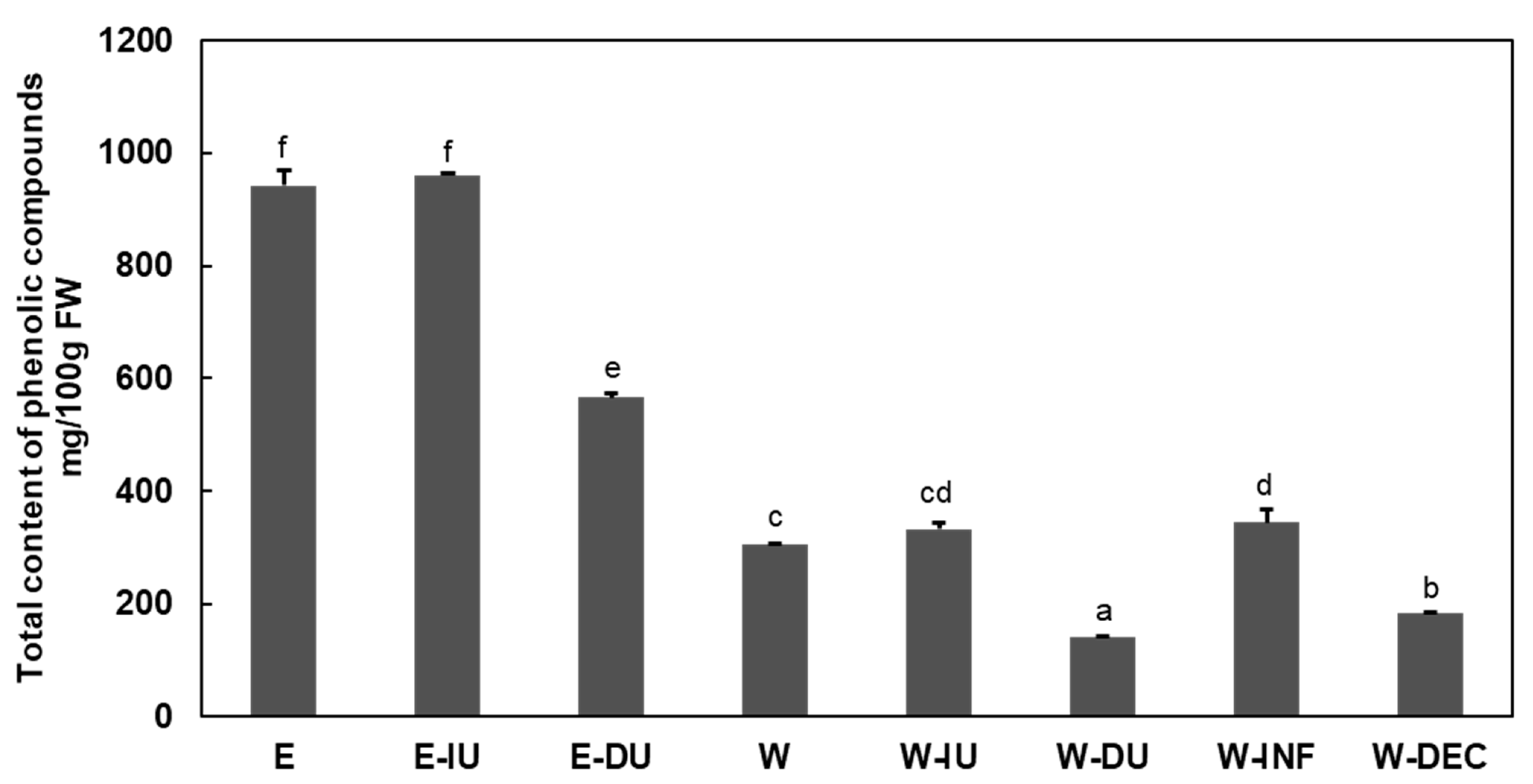
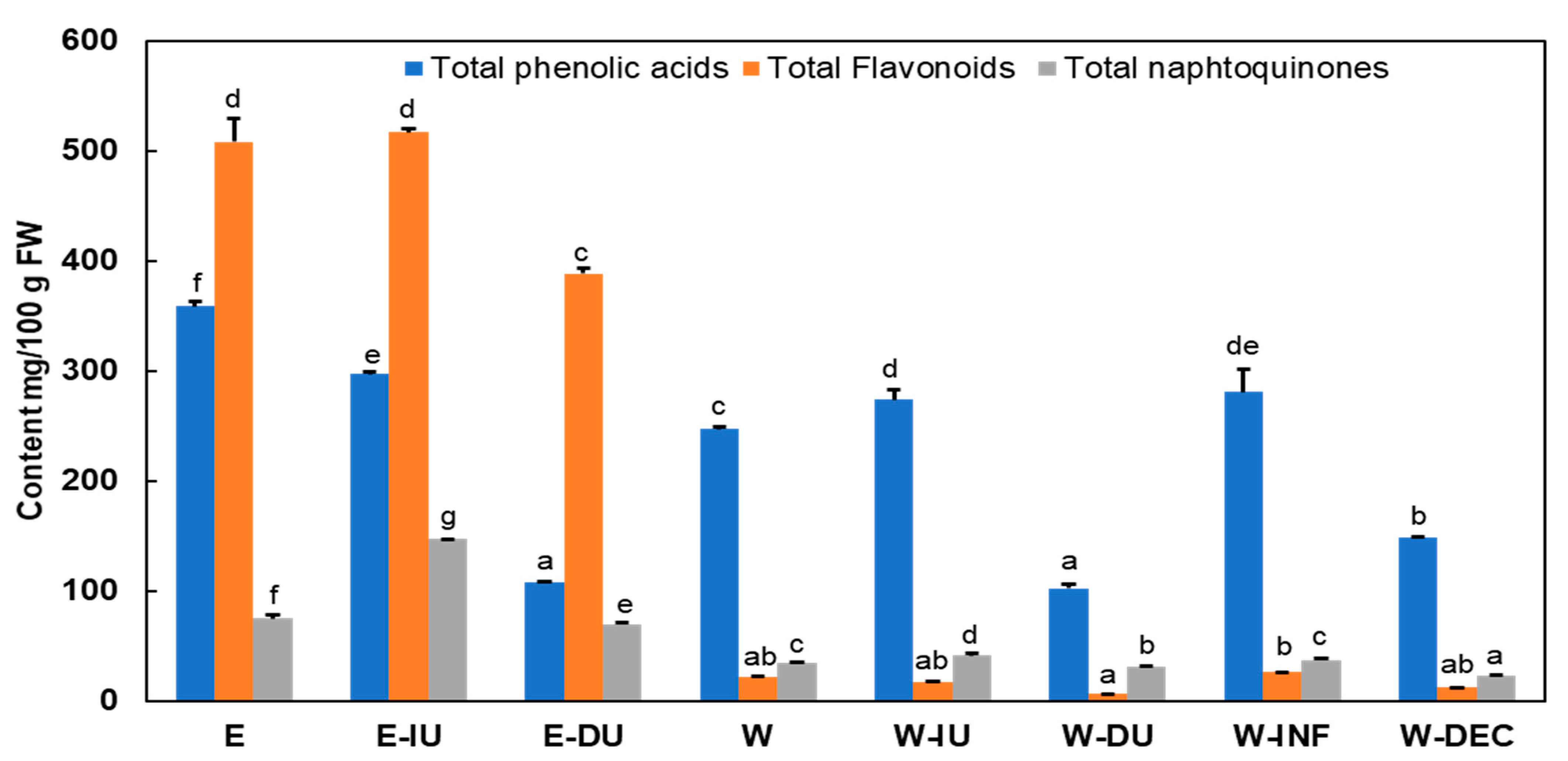
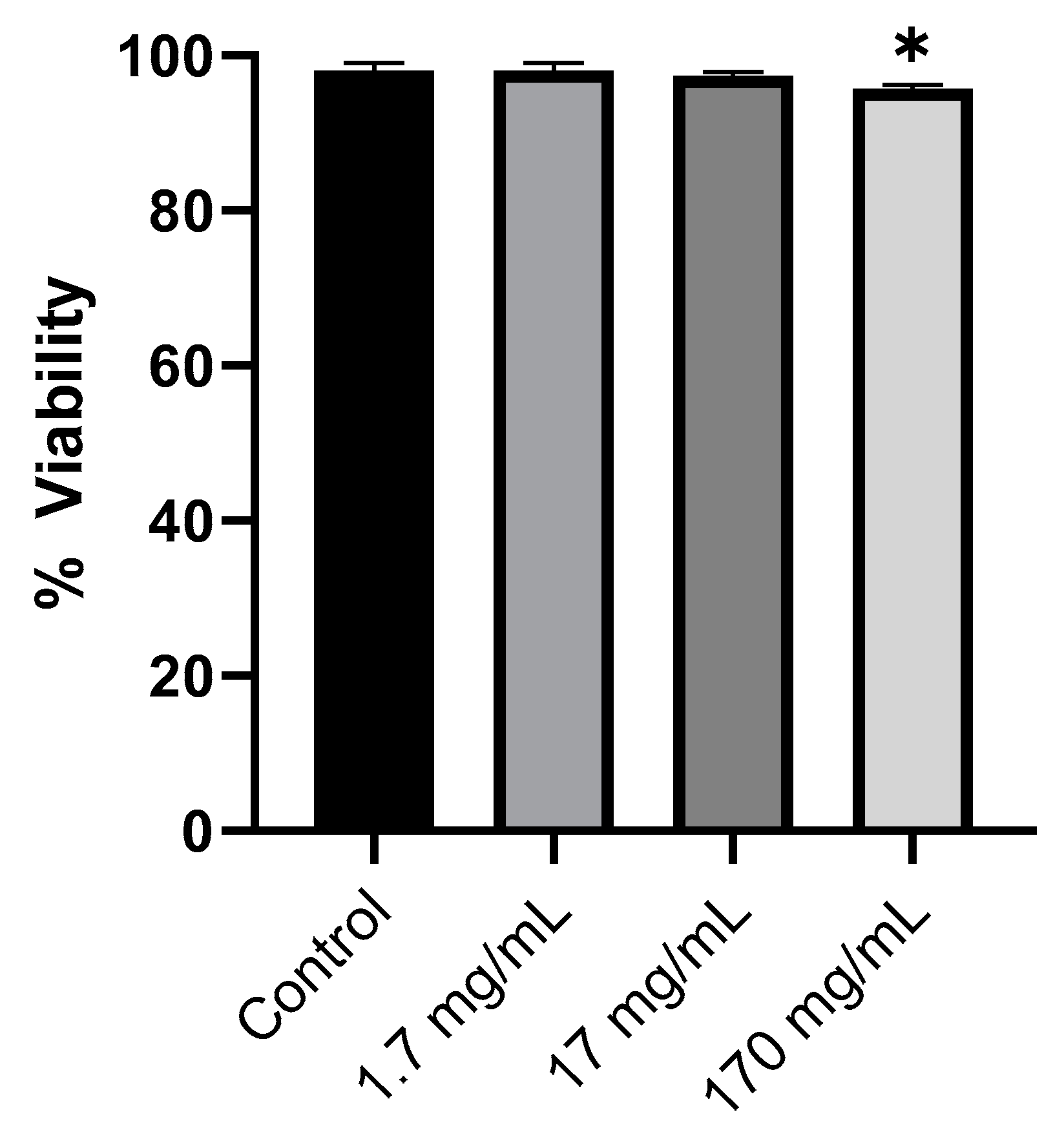

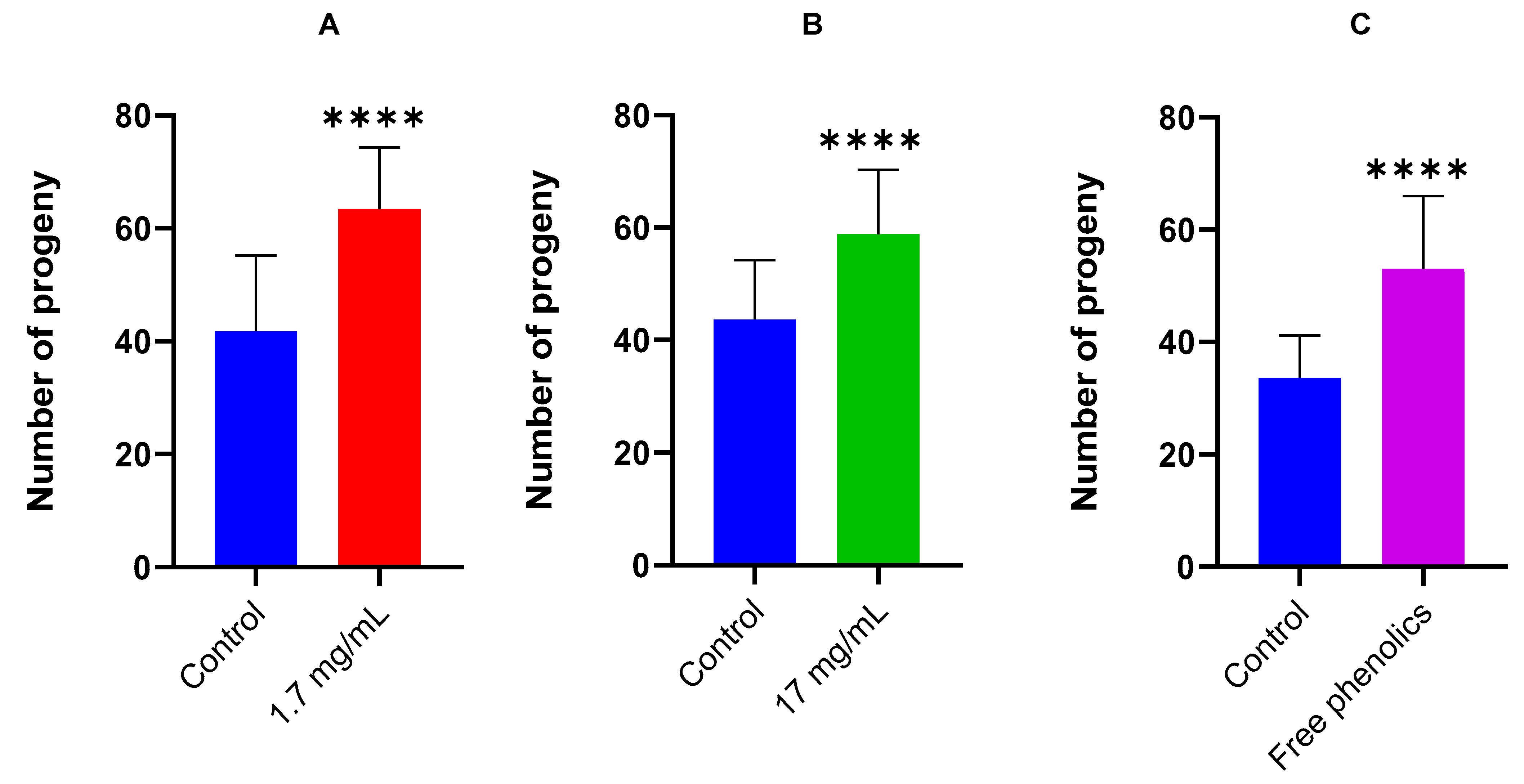
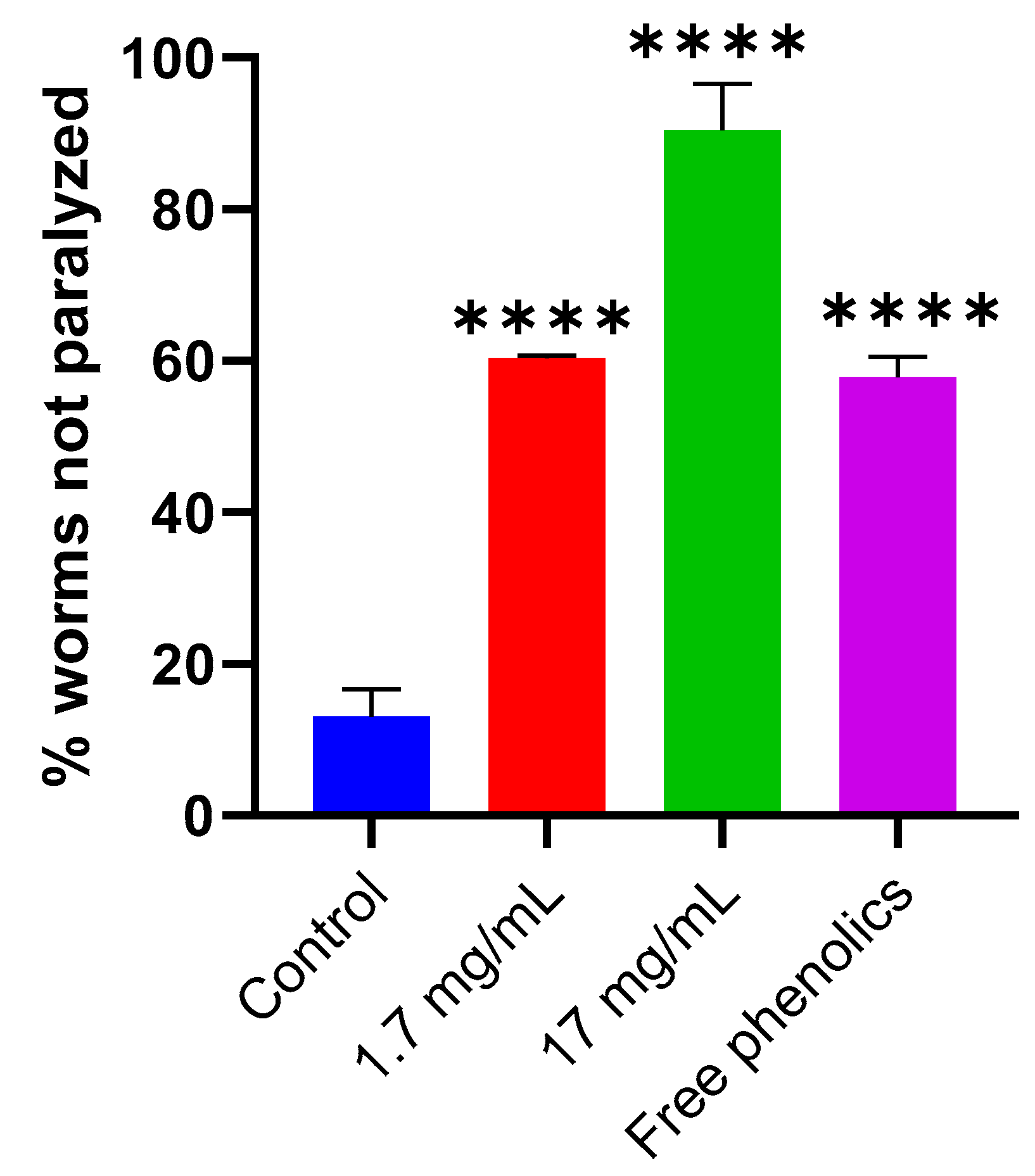
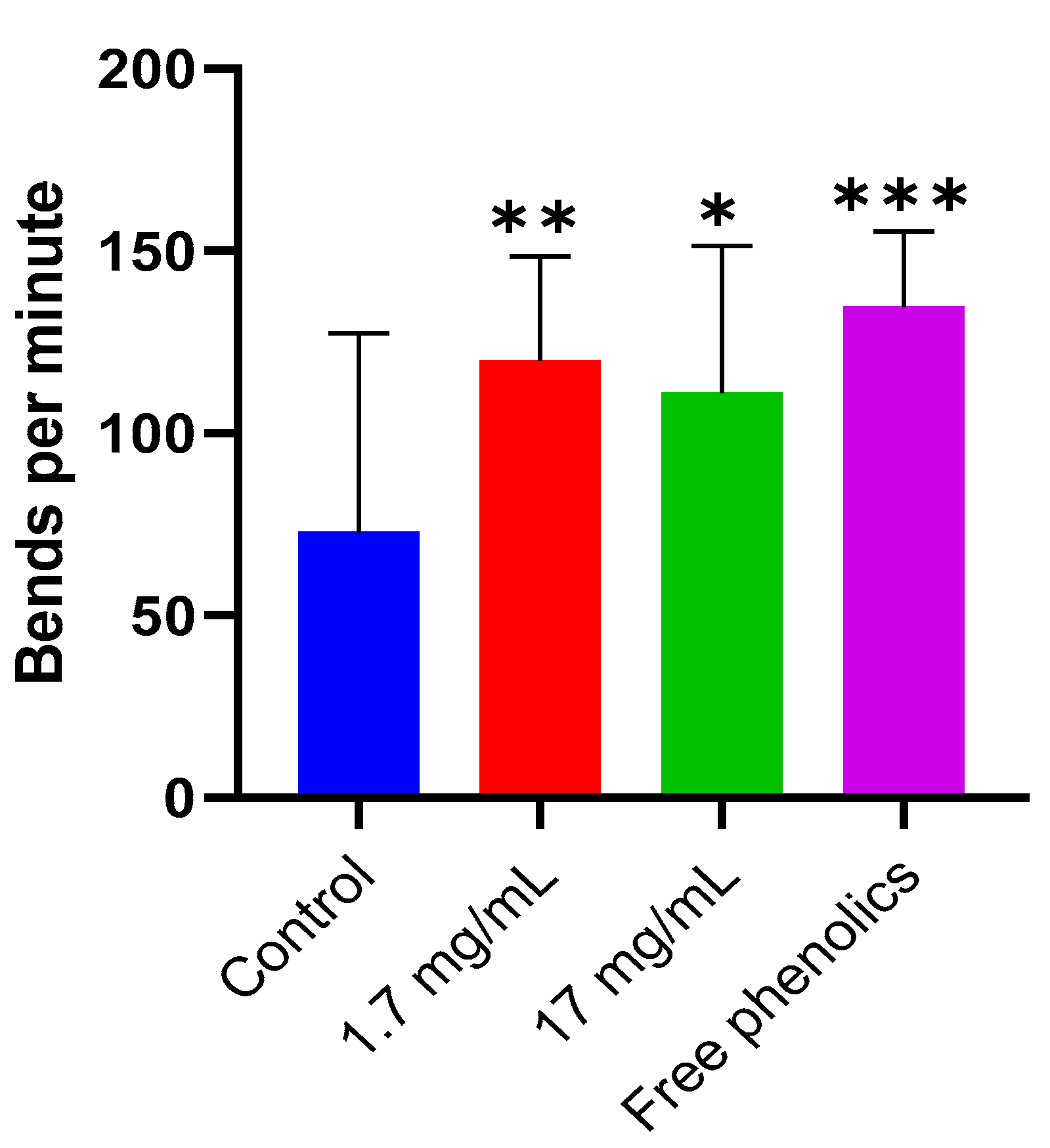
| # | Rt (min) | Compounds | λₘₐₓ | [M-H]− | Fragments | Equivalents |
|---|---|---|---|---|---|---|
| 1 | 12.445 | cis-3-caffeolquinic acid | 319 | 353 | 191, 179, 135 | Chlorogenic acid |
| 2 | 13.413 | trans-3-caffeolquinic acid | 324 | 353 | 191, 179, 135 | Chlorogenic acid |
| 3 | 15.523 | cis-3-p-coumaryolquinic acid | 306 | 337 | 163, 191, 119 | p-Coumaric acid |
| 4 | 15.937 | trans-3-p-coumaryolquinic acid | 308 | 337 | 163, 191, 119 | Chlorogenic acid |
| 5 | 17.263 | 4-Caffeolquinic acid | 327 | 353 | 173, 179, 135 | Chlorogenic acid |
| 6 | 18.035 | Dihydroxytetralone hexoside | 262, 321 | 339 | 177, 159 | α-tetralone |
| 7 | 18.553 | Benzoic acid pentoside | 307 | 253 | 121 | Benzoic acid |
| 8 | 20.095 | cis-4-p-coumaryolquinic acid | 307 | 337 | 173 | p-Coumaric acid |
| 9 | 21.068 | trans-4-p-coumaryolquinic acid | 311 | 337 | 173 | p-Coumaric acid |
| 10 | 29.257 | Taxifolin pentoside isomer 1 | 290 | 435 | 303 | Taxifolin |
| 11 | 33.335 | Taxifolin pentoside isomer 2 | 290 | 435 | 303 | Taxifolin |
| 12 | 34.177 | Caffeic acid derivative | 330 | 501 | 281, 179 | Caffeic acid |
| 13 | 37.767 | Coumaric acid hexoside derivative 1 | 311 | 485 | 325, 163 | p-Coumaric acid |
| 14 | 39.238 | Coumaric acid hexoside derivative 2 | 311 | 485 | 325, 163 | p-Coumaric acid |
| 15 | 19.9 | Hydrojunglone glucoside | 364 | 337 | 175 | Juglone |
| 16 | 24.602 | Myrecetin hexoside isomer 1 | 255, 356 | 479 | 317 | Myrecetin-3-O-gal |
| 17 | 24.877 | Myrecetin hexoside isomer 2 | 255, 356 | 479 | 317 | Myrecetin-3-O-gal |
| 18 | 24.047 | Myrecetin pentoside isomer 1 | 255, 356 | 449 | 317 | Myrecetin-3-O-gal |
| 19 | 26.975 | Myrecetin pentoside isomer 2 | 255, 357 | 449 | 317 | Myrecetin-3-O-gal |
| 20 | 27.338 | Myrecetin rhamnoside | 262, 348 | 463 | 317 | Myrecetin-3-O-gal |
| 21 | 28.008 | Q-hexoside isomer 1 | 255, 350 | 463 | 301 | Quercetin-3-O-glc |
| 22 | 28.397 | Q-hexoside isomer 2 | 255, 353 | 463 | 301 | Quercetin-3-O-glc |
| 23 | 29.837 | Q-pentoside isomer 1 | 255, 352 | 433 | 301 | Quercetin-3-O-glc |
| 24 | 30.518 | Q-pentoside isomer 2 | 255, 352 | 433 | 301 | Quercetin-3-O-glc |
| 25 | 31.145 | Q-pentoside isomer 3 | 255, 350 | 433 | 301 | Quercetin-3-O-glc |
| 26 | 31.542 | Q-rhamnoside | 255, 346 | 447 | 301 | Quercetin-3-O-glc |
| 27 | 32.955 | K-pentoside | 262, 342 | 417 | 285 | Nicotiflorin |
| 28 | 34.675 | K-rhamnoside | 363, 340 | 431 | 285 | Nicotiflorin |
| 29 | 36.903 | Q-acetyl-rhamnoside isomer 1 | 255, 347 | 489 | 301 | Quercetin-3-O-glc |
| 30 | 37.973 | Q-acetyl-rhamnoside isomer 2 | 255, 341 | 489 | 301 | Quercetin-3-O-glc |
| 31 | 38.017 | Juglone derivative | 323, 422 | 489 | 173 | Juglone |
| 32 | 43.507 | Juglone | 349, 422 | 173 | 155 | Juglone |
| Compound Concentration mg/100 g FW | ||||||||
|---|---|---|---|---|---|---|---|---|
| Ethanol 80% | Water | |||||||
| Peak Name | E | E-IU | E-DU | W | W-IU | W-DU | W-INF | W-DEC |
| cis-3-Caffeolquinic acid | 15.7 ± 0.1 (2%) | 16.8 ± 0.1 (2%) | 7.7 ± 0.0 (1%) | 3.0 ± 0.0 (1%) | 18.0 ± 0.5 (5%) | 6.9 ± 0.7 (5%) | 18.6 ± 1.4 (5%) | 8.1 ± 0.1 (4%) |
| trans-3-Caffeolquinic acid | 235.1 ± 1.2 (25%) | 200.8 ± 1.8 (21%) | 67.4 ± 1.1 (12%) | 232.2 ± 1.3 (76%) | 204.6 ± 6.6 (62%) | 68.4 ± 1.6 (49%) | 203.6 ± 14.1 (59%) | 95.5 ± 0.3 (52%) |
| cis-3-p-coumaryolquinic acid | 8.3 ± 0.0 (1%) | 4.2 ± 0.0 (0%) | 1.1 ± 0.1 (0%) | 0.2 ± 0.0 (0%) | 4.5 ± 0.1 (1%) | 1.1 ± 0.0 (1%) | 4.2 ± 0.2 (1%) | 2.2 ± 0.0 (1%) |
| trans-3-p-coumaryolquinic acid | 28.4 ± 0.1 (3%) | 12.4 ± 0.1 (1%) | 3.0 ± 0.1 (1%) | 2.2 ± 0.3 (1%) | 12.2 ± 0.3 (4%) | 6.4 ± 0.0 (5%) | 14.7 ± 0.6 (4%) | 6.5 ± 0.1 (4%) |
| 4-caffeolquinic acid | 45.3 ± 0.5 (5%) | 35.4 ± 0.4 (4%) | 13.5 ± 0.4 (2%) | 4.5 ± 0.1 (1%) | 29.7 ± 1.5 (9%) | 16.4 ± 0.1 (12%) | 31.2 ± 3.0 (9%) | 30.6 ± 0.2 (17%) |
| Dihydroxytetralone hexoside | 23.0 ± 1 (2%) | 23.1 ± 0.1 (2%) | 24.4 ± 0.9 (4%) | 19.5 ± 0.0 (6%) | 21.0 ± 1.2 (6%) | 15.6 ± 0.3 (11%) | 19.4 ± 0.8 (6%) | 12.9 ± 0.6 (7%) |
| Benzoic acid pentoside | 6.0 ± 0.6 (1%) | 4.3 ± 0.1 (0%) | 2.9 ± 0.1 (1%) | 1.4 ± 0.0 (0%) | 3.1 ± 0.2 (1%) | 2.3 ± 0.2 (2%) | 3.4 ± 1.4 (1%) | 2.2 ± 0.1 (1%) |
| cis-4-p-coumaryolquinic acid | 2.0 ± 0.4 (0%) | 0.9 ± 0.0 (0%) | 0.3 ± 0.0 (0%) | 0.1 ± 0.0 (0%) | 0.5 ± 0.0 (0%) | 0.3 ± 0.0 (0%) | 0.6 ± 0.0 (0%) | 0.4 ± 0.0 (0%) |
| trans-4-p-coumaryolquinic acid | 2.8 ± 0.1 (0%) | 0.3 ± 0.0 (0%) | 0.7 ± 0.0 (0%) | 0.1 ± 0.0 (0%) | 0.5 ± 0.0 (0%) | 0.3 ± 0.0 (0%) | 1.0 ± 0.0 (0%) | 1.2 ± 0.0 (1%) |
| Taxifolin pentoside-iso 1 | 40.2 ± 0.1 (4%) | 31.5 ± 0.5 (3%) | 26.1 ± 0.2 (5%) | 9.4 ± 0.1 (3%) | 8.5 ± 0.3 (3%) | 6.3 ± 0.0 (4%) | 8.6 ± 0.0 (3%) | 3.6 ± 0.1 (2%) |
| Taxifolin pentoside-iso 2 | 21.6 ± 0.1 (2%) | 16.3 ± 0.5 (2%) | 14.9 ± 0.2 (3%) | 8.1 ± 0.0 (3%) | 7.7 ± 0.1 (2%) | nd | 7.5 ± 0.0 (2%) | 3.2 ± 0.1 (2%) |
| Caffeic acid derivative | 6.4 ± 0.2 (1%) | 10.1 ± 0.3 (1%) | 8.0 ± 0.8 (1%) | 3.1 ± 0.0 (1%) | 0.3 ± 0.0 (0%) | nd | 2.6 ± 0.1 (1%) | 1.1 ± 0.0 (1%) |
| Coumaric acid hexoside der 1 | 6.5 ± 0.5 (1%) | 7.7 ± 0.1 (1%) | 2.1 ± 0.1 (0%) | 0.4 ± 0.0 (0%) | 0.5 ± 0.0 (0%) | 0.5 ± 0.0 (0%) | 1.0 ± 0.0 (0%) | 1.0 ± 0.0 (0%) |
| Coumaric acid hexoside der 2 | 2.4 ± 0.2 (0%) | 4.4 ± 0.1 (0%) | 1.6 ± 0.0 (0%) | nd | nd | nd | nd | nd |
| Hydrojunglone glucoside | 22.2 ± 0.5 (2%) | 21.4 ± 1.2 (2%) | 22.1 ± 0.7 (4%) | 15.4 ± 0.2 (5%) | 20.1 ± 0.6 (6%) | 15.5 ± 0.9 (11%) | 17.9 ± 0.4 (5%) | 10.4 ± 0.0 (6%) |
| Myrecetin hexoside iso 1 | 10.8 ± 0.2 (1%) | 4.8 ± 0.1 (1%) | 1.8 ± 0.1 (0%) | 0.7 ± 0.0 (0%) | nd | nd | nd | 0.3 ± 0.0 (0%) |
| Myrecetin hexoside iso 2 | 4.2 ± 0.1 (0%) | 1.3 ± 0.4 (0%) | 0.6 ± 0.0 (0%) | nd | nd | nd | nd | nd |
| Myrecetin pentoside iso 1 | 3.2 ± 0.1 (0%) | 0.6 ± 0.0 (0%) | 0.6 ± 0.0 (0%) | nd | nd | nd | nd | nd |
| Myrecetin pentoside iso 2 | 1.8 ± 0.1 (1%) | 1.0 ± 0.0 (0%) | 1.0 ± 0.0 (0%) | nd | nd | nd | 0.7 ± 0.0 (0%) | 0.3 ± 0.0 (0%) |
| Myrecetin rhamnoside | 9.5 ± 0.2 (1%) | 3.8 ± 0.3 (0%) | 1.1 ± 0.1 (0%) | nd | nd | nd | nd | nd |
| Q-hexoside iso 1 | 99.4 ± 4.5 (10%) | 106.6 ± 1.4 (11%) | 73.1 ± 1.2 (13%) | nd | 1.0 ± 0.0 (0%) | nd | 6.1 ± 0.0 (2%) | 3.3 ± 0.1 (2%) |
| Q-hexoside iso 2 | 32.1 ± 1.5 (3%) | 26.3 ± 0.5 (3%) | 17.6 ± 0.3 (3%) | nd | nd | nd | nd | nd |
| Q-pentoside iso 1 | 9.1 ± 0.6 (1%) | 12.2 ± 0.2 (1%) | 8.1 ± 0.2 (1%) | nd | nd | nd | nd | nd |
| Q-pentoside iso 2 | 55.7 ± 3.4 (5%) | 63.2 ± 1.4 (7%) | 46.3 ± 1.2 (8%) | nd | nd | nd | nd | nd |
| Q-pentoside iso 3 | 61.2 ± 3.2 (6%) | 71.9 ± 0.3 (7%) | 50.8 ± 1.6 (9%) | nd | nd | nd | nd | nd |
| Q-rhamnoside | 59.3 ± 1.4 (6%) | 56.3 ± 0.8 (6%) | 44.5 ± 1.7 (8%) | 0.2 ± 0.0 (0%) | nd | nd | 1.7 ± 0.1 (0%) | 0.9 ± 0.0 (0%) |
| K-pentoside | 35.3 ± 1.3 (4%) | 43.4 ± 0.9 (5%) | 38.7 ± 0.1 (7%) | 1.6 ± 0.1 (1%) | nd | nd | 0.5 ± 0.0 (0%) | 0.3 ± 0.0 (0%) |
| K-rhamnoside | 59.5 ± 4.3 (6%) | 66.8 ± 0.4 (7%) | 56.7 ± 1.8 (10%) | 2.4 ± 0.0 (1%) | nd | nd | 0.8 ± 0.0 (0%) | 0.2 ± 0.0 (0%) |
| Q-acetyl-rhamnoside iso 1 | 4.1 ± 0.3 (0%) | 8.8 ± 0.8 (1%) | 4.9 ± 0.1 (1%) | nd | nd | nd | nd | nd |
| Q-acetyl-rhamnoside iso 2 | 1.1 ± 0.3 (0%) | 1.7 ± 0.1 (0%) | 1.3 ± 0.0 (0%) | nd | nd | nd | nd | nd |
| Juglone der | 10.0 ± 0.6 (1%) | 5.3 ± 0.1 (1%) | 4.1 ± 0.1 (1%) | nd | nd | nd | nd | nd |
| Juglone | 19.6 ± 2.2 (2%) | 97.2 ± 1.0 (10%) | 19.0 ± 0.3 (3%) | nd | nd | nd | nd | nd |
Disclaimer/Publisher’s Note: The statements, opinions and data contained in all publications are solely those of the individual author(s) and contributor(s) and not of MDPI and/or the editor(s). MDPI and/or the editor(s) disclaim responsibility for any injury to people or property resulting from any ideas, methods, instructions or products referred to in the content. |
© 2025 by the authors. Licensee MDPI, Basel, Switzerland. This article is an open access article distributed under the terms and conditions of the Creative Commons Attribution (CC BY) license (https://creativecommons.org/licenses/by/4.0/).
Share and Cite
Hamdi, A.; Córdoba-Rojano, M.A.; Monje-Moreno, J.M.; Guillén-Izquierdo, E.; Rodríguez-Arcos, R.; Jiménez-Araujo, A.; Muñoz-Ruiz, M.J.; Guillén-Bejarano, R. Harnessing the Potential of Walnut Leaves from Nerpio: Unveiling Extraction Techniques and Bioactivity Through Caenorhabditis elegans Studies. Foods 2025, 14, 1048. https://doi.org/10.3390/foods14061048
Hamdi A, Córdoba-Rojano MA, Monje-Moreno JM, Guillén-Izquierdo E, Rodríguez-Arcos R, Jiménez-Araujo A, Muñoz-Ruiz MJ, Guillén-Bejarano R. Harnessing the Potential of Walnut Leaves from Nerpio: Unveiling Extraction Techniques and Bioactivity Through Caenorhabditis elegans Studies. Foods. 2025; 14(6):1048. https://doi.org/10.3390/foods14061048
Chicago/Turabian StyleHamdi, Amel, Miguel Angel Córdoba-Rojano, Jose Manuel Monje-Moreno, Elisa Guillén-Izquierdo, Rocío Rodríguez-Arcos, Ana Jiménez-Araujo, Manuel Jesús Muñoz-Ruiz, and Rafael Guillén-Bejarano. 2025. "Harnessing the Potential of Walnut Leaves from Nerpio: Unveiling Extraction Techniques and Bioactivity Through Caenorhabditis elegans Studies" Foods 14, no. 6: 1048. https://doi.org/10.3390/foods14061048
APA StyleHamdi, A., Córdoba-Rojano, M. A., Monje-Moreno, J. M., Guillén-Izquierdo, E., Rodríguez-Arcos, R., Jiménez-Araujo, A., Muñoz-Ruiz, M. J., & Guillén-Bejarano, R. (2025). Harnessing the Potential of Walnut Leaves from Nerpio: Unveiling Extraction Techniques and Bioactivity Through Caenorhabditis elegans Studies. Foods, 14(6), 1048. https://doi.org/10.3390/foods14061048










